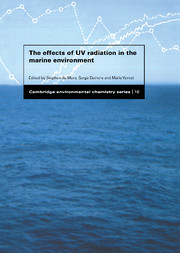Book contents
- Frontmatter
- Contents
- Contributors
- Preface
- 1 Enhanced UV radiation – a new problem for the marine environment
- 2 UV physics and optics
- 3 Spectral weighting functions for quantifying effects of UV radiation in marine ecosystems
- 4 Marine photochemistry and its impact on carbon cycling
- 5 Photochemical production of biological substrates
- 6 Mechanisms of UV damage to aquatic organisms
- 7 Strategies for the minimisation of UV-induced damage
- 8 UV radiation effects on heterotrophic bacterioplankton and viruses in marine ecosystems
- 9 Effects of UV radiation on the physiology and ecology of marine phytoplankton
- 10 Impact of solar UV radiation on zooplankton and fish
- 11 Implications of UV radiation for the food web structure and consequences on the carbon flow
- Index
1 - Enhanced UV radiation – a new problem for the marine environment
Published online by Cambridge University Press: 20 August 2009
- Frontmatter
- Contents
- Contributors
- Preface
- 1 Enhanced UV radiation – a new problem for the marine environment
- 2 UV physics and optics
- 3 Spectral weighting functions for quantifying effects of UV radiation in marine ecosystems
- 4 Marine photochemistry and its impact on carbon cycling
- 5 Photochemical production of biological substrates
- 6 Mechanisms of UV damage to aquatic organisms
- 7 Strategies for the minimisation of UV-induced damage
- 8 UV radiation effects on heterotrophic bacterioplankton and viruses in marine ecosystems
- 9 Effects of UV radiation on the physiology and ecology of marine phytoplankton
- 10 Impact of solar UV radiation on zooplankton and fish
- 11 Implications of UV radiation for the food web structure and consequences on the carbon flow
- Index
Summary
Introduction
UV irradiance at the earth's surface is intimately related to stratospheric ozone. This gas tends to be concentrated in the lower stratosphere (hence the notion of an ozone layer) and is primarily responsible for the absorption of solar UV radiation (UVR). UVR has been recognised for many years (e.g. Worrest, Dyke & Thomson, 1978; Worrest et al., 1981; Calkins, 1982) as a potential stress for organisms in a variety of environments and as a factor in biogeochemical cycling (Zepp, Callaghan & Erickson, 1995). The trend in recent years of an intensifying, but periodic, anthropogenic-induced decline in stratospheric ozone concentrations with concurrent enhanced UV-B radiation is quite alarming. Altered solar radiation regimes can potentially upset established balances in marine ecosystems and thus presents a new problem. Most attention has been given to the ‘ozone hole’ over Antarctica that has been recorded annually since the 1980s. However, recent observations have confirmed measurable ozone losses over other regions, including the development of an Arctic ozone hole. The major factor responsible for the destruction of the ozone layer is anthropogenic emissions of chlorofluorocarbons (CFCs). These gases, having no natural sources, are non-toxic and inert in the troposphere, but are photolysed in the stratosphere, thereby releasing reactive chlorine atoms that catalytically destroy ozone. Other anthropogenic contributions to ozone depletion may include global changes in land use and the increased emission of nitrogen dioxide as a result of fertiliser applications (Bouwman, 1998). Paradoxically, the anthropogenic emissions of greenhouse gases that tend to cause a temperature increase at the earth's surface also produce a decrease in stratospheric temperatures.
- Type
- Chapter
- Information
- Publisher: Cambridge University PressPrint publication year: 2000
- 27
- Cited by



